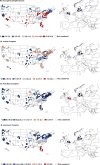Ecological Analyses of Mycobacteria in Showerhead Biofilms and Their Relevance to Human Health
- PMID: 30377276
- PMCID: PMC6212831
- DOI: 10.1128/mBio.01614-18
Ecological Analyses of Mycobacteria in Showerhead Biofilms and Their Relevance to Human Health
Abstract
Bacteria within the genus Mycobacterium can be abundant in showerheads, and the inhalation of aerosolized mycobacteria while showering has been implicated as a mode of transmission in nontuberculous mycobacterial (NTM) lung infections. Despite their importance, the diversity, distributions, and environmental predictors of showerhead-associated mycobacteria remain largely unresolved. To address these knowledge gaps, we worked with citizen scientists to collect showerhead biofilm samples and associated water chemistry data from 656 households located across the United States and Europe. Our cultivation-independent analyses revealed that the genus Mycobacterium was consistently the most abundant genus of bacteria detected in residential showerheads, and yet mycobacterial diversity and abundances were highly variable. Mycobacteria were far more abundant, on average, in showerheads receiving municipal water than in those receiving well water and in U.S. households than in European households, patterns that are likely driven by differences in the use of chlorine disinfectants. Moreover, we found that water source, water chemistry, and household location also influenced the prevalence of specific mycobacterial lineages detected in showerheads. We identified geographic regions within the United States where showerheads have particularly high abundances of potentially pathogenic lineages of mycobacteria, and these "hot spots" generally overlapped those regions where NTM lung disease is most prevalent. Together, these results emphasize the public health relevance of mycobacteria in showerhead biofilms. They further demonstrate that mycobacterial distributions in showerhead biofilms are often predictable from household location and water chemistry, knowledge that advances our understanding of NTM transmission dynamics and the development of strategies to reduce exposures to these emerging pathogens.IMPORTANCE Bacteria thrive in showerheads and throughout household water distribution systems. While most of these bacteria are innocuous, some are potential pathogens, including members of the genus Mycobacterium that can cause nontuberculous mycobacterial (NTM) lung infection, an increasing threat to public health. We found that showerheads in households across the United States and Europe often harbor abundant mycobacterial communities that vary in composition depending on geographic location, water chemistry, and water source, with households receiving water treated with chlorine disinfectants having particularly high abundances of certain mycobacteria. The regions in the United States where NTM lung infections are most common were the same regions where pathogenic mycobacteria were most prevalent in showerheads, highlighting the important role of showerheads in the transmission of NTM infections.
Keywords: Mycobacterium; NTM lung disease; nontuberculous mycobacterial infection; plumbing biofilms.
Copyright © 2018 Gebert et al.
Figures





Similar articles
-
A Global Survey of Mycobacterial Diversity in Soil.Appl Environ Microbiol. 2019 Aug 14;85(17):e01180-19. doi: 10.1128/AEM.01180-19. Print 2019 Sep 1. Appl Environ Microbiol. 2019. PMID: 31253672 Free PMC article.
-
Shower dehumidification to reduce nontuberculous mycobacteria aerosolization.BMC Res Notes. 2024 Mar 28;17(1):91. doi: 10.1186/s13104-024-06751-6. BMC Res Notes. 2024. PMID: 38549125 Free PMC article.
-
Identification of nontuberculous mycobacteria isolated from household showerheads of patients with nontuberculous mycobacteria.Sci Rep. 2022 May 23;12(1):8648. doi: 10.1038/s41598-022-12703-6. Sci Rep. 2022. PMID: 35606401 Free PMC article.
-
Infection Source and Epidemiology of Nontuberculous Mycobacterial Lung Disease.Tuberc Respir Dis (Seoul). 2019 Apr;82(2):94-101. doi: 10.4046/trd.2018.0026. Epub 2018 Sep 28. Tuberc Respir Dis (Seoul). 2019. PMID: 30302953 Free PMC article. Review.
-
Current Epidemiologic Trends of the Nontuberculous Mycobacteria (NTM).Curr Environ Health Rep. 2016 Jun;3(2):161-7. doi: 10.1007/s40572-016-0086-z. Curr Environ Health Rep. 2016. PMID: 27020801 Review.
Cited by
-
Hawaiian Volcanic Ash, an Airborne Fomite for Nontuberculous Mycobacteria.Geohealth. 2023 Dec 30;8(1):e2023GH000889. doi: 10.1029/2023GH000889. eCollection 2024 Jan. Geohealth. 2023. PMID: 38161597 Free PMC article.
-
Socio-Economic and Environmental Factors Related to Spatial Differences in Human Non-Tuberculous Mycobacterial Diseases in the Czech Republic.Int J Environ Res Public Health. 2019 Oct 17;16(20):3969. doi: 10.3390/ijerph16203969. Int J Environ Res Public Health. 2019. PMID: 31627484 Free PMC article.
-
Incidence of Nontuberculous Mycobacterial Pulmonary Infection, by Ethnic Group, Hawaii, USA, 2005-2019.Emerg Infect Dis. 2022 Aug;28(8):1543-1550. doi: 10.3201/eid2808.212375. Emerg Infect Dis. 2022. PMID: 35876462 Free PMC article. Review.
-
Looking beyond Typical Treatments for Atypical Mycobacteria.Antibiotics (Basel). 2020 Jan 3;9(1):18. doi: 10.3390/antibiotics9010018. Antibiotics (Basel). 2020. PMID: 31947883 Free PMC article. Review.
-
Public Health Risks Associated with Heavy Metal and Microbial Contamination of Drinking Water in Australia.Int J Environ Res Public Health. 2019 Oct 18;16(20):3982. doi: 10.3390/ijerph16203982. Int J Environ Res Public Health. 2019. PMID: 31635303 Free PMC article.
References
Publication types
MeSH terms
Substances
LinkOut - more resources
Full Text Sources
Medical
Molecular Biology Databases
